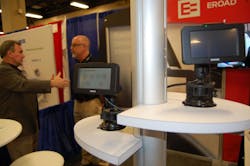For late adopters of ELDs simplicity will be the key
So I got a few minutes to talk with Norm Ellis, president of EROAD, here at the Truckload Carriers Association (TCA) annual convention in Nashville, TN.
Ellis – a longtime veteran of the trucking industry with loads of technology experience – explained to me that we are rapidly approaching the “point of no return” as he’s dubbed it in terms of when those fleets that have not yet begun to install electronic logging devices (ELDs) to comply with the impending December mandate should do so in order to allow for adequate installation and driver training time.
“There are not as many fleets on the fence anymore,” he told me. “But while there are almost all off the fence they are moving much more slowly than we thought” in terms of adopting some sort of ELD solution.
Ellis believes that fleets with 150 or more trucks that haven’t begun installing ELDs yet “really can’t go beyond May or June” of this year to start implementing some sort of solution. “They need time to install the devices and more importantly time to train their drivers on them,” he stressed.
EROAD released its in-cab ELD system commercially back in February this year and Ellis feels pretty strongly that such “tethered” devices – ones that stay in the truck cab – are going to be a much more simpler solution to ELD compliance versus ELD apps installed on smart phones or tablet computers.
“Will the phone or tablet ‘sync up’ via Bluetooth properly every time? What happens if you drop and damage your phone or tablet?” he said. “When you hand those devices over to a roadside inspection officer, are there privacy concerns since these devices are the driver’s own property?”
Yet Ellis also stressed that with “tethered” ELDs, a truck’s VIN or vehicle identification number will be very critical as the cable needed to hook the ELD up to a truck differs by brand and model year.
Arguments can be made back and forth over this topic – many ELD providers believes smart phones and tablets are excellent options for drivers and fleets alike – but one thing all the ELD providers seem to share in this space is the belief that “peer-to-peer” training will be critical to fostering the willing use of this technology.
Ellis noted that EROAD’s ELD installation plan when it works with a fleet is to take that fleet’s top six to 10 drivers and train them first on the technology – drivers that are the fleet’s safest and also the ones who are embrace technology.
These are the drivers that jump at the chance to try anything to make their work lives simpler – especially when it comes to ditching paperwork, Ellis stressed.
“These are the guys who will show the other drivers and say, look, these devices record everything that is required, so I go straight go home to my family without spending time filling out paperwork,” he said. “That peer-to-peer relationship is what will convince other drivers to change.”Typically for a 150 truck fleet, Ellis said EROAD needs about a month and a half to install the devices and ten will train the best six to 10 drivers first on how to use the technology.
Then, two weeks later, EROAD will train another 20 drivers, followed by a group of 40, and so on until they are all trained. That initial group also helps spread the word about how to use the ELDs and act as “coaches” to other drivers in the fleet as needed.
“Fleets, particularly small and medium operations, want this [ELD] adoption process to be as simple, easy, and driver-friendly as possible,” he told me. “They know – as all the drivers know – that there is no other option now. Drivers can’t leave to go to a fleet that isn’t using ELDs anymore; everyone will be using them.”


